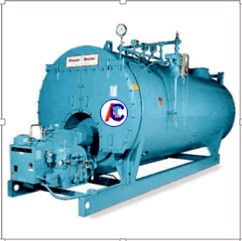This procedure is for cleaning carbonate based mineral scale from the waterside of steam boilers. Additional steam boiler cleaner products and steps will be required if you suspect that the majority of the scale is not calcium carbonate. Also note that it is rare that the entire boiler surface is completely clean after acid cleaning. It is difficult to get enough circulation and velocity to all parts of the boiler to remove all the scale. This procedure may need to be repeated several times if the severity of the scale is substantial. Lastly, the acid used for this cleaning is hydrochloric acid which produces fumes with normal use. Be sure to have adequate ventilation to the outside when using this product.
How Should You Clean Your Steam Boiler?

Ideal Procedure for Cleaning Your Steam Boiler
Follow this procedure to get a clean steam boiler:
- Isolate the boiler by closing the gate valves as close to the vessel as possible.
Keep the top manhole open to allow for periodic inspections during the cleaning.
- Estimate the total number of gallons of water the vessel section will contain.
Calculate the amount of initial acid to use to get a 1-5% concentration of Chardon’s Scalzo in the boiler. Use only Scalzo to prevent excessive steel corrosion while the cleaning is taking place.
- Fill the boiler to capacity with water.
Immediately add the Scalzo followed by a small amount of Chardon’s CTA-800 (4 oz per 1000 gallons). Check pH before starting boiler knowing it has not mixed in well just yet. pH should be between 1-3.
- Promptly have the boiler operator operate the boiler to heat the cleaning solution in the boiler to a maximum of 130 F.
DO NOT BOIL THE WATER. Be sure to check the temperature since above the temperature causes excessive corrosion of the steel by the chlorides in the cleaning solution. Generally, when the water just starts to move inside the boiler, it is at the correct temperature. The velocity of the water inside the boiler aids in dispersing the dissolved calcium and provides contact of scale with fresh acid to continue cleaning. If an air lance is available, use it to provide an air bubbling action at the bottom of the boiler vessel which encourages circulation.
- Continue turning on and off the boiler to maintain the temperature in the range of 100-130F.
Check pH every 15 minutes; (should be 1 or 2). If higher, add Scalzo to depress the pH back to 1-2 pH.
- Continue step 5 until pH remains at 1 or 2 for 120 minutes or more, depending on scale build-up.
The system is then as clean as it will be with the current cleaning solution. Neutralize the cleaning solution to a pH of 5.0 with Chardon’s BD-6 by adding it to the vessel and circulating the mixture for a few minutes. Check pH – add more BD-6 if needed and circulate if necessary. Drain the solution from the boiler as quickly as possible.
- Add city water to the vessel and continue rinsing the boiler internals.
Drain again and inspect for level of cleaning success. If further cleaning is desired, repeat the cleaning process with fresh Scalzo.
- If cleaning is successful, immediately refill the boiler with water and add chemicals to get pH to 11 and sulfite to 200 ppm.
Replace manhole and have operator re-fire the boiler and bring to normal operating temperature.
The Association of Water Technologies weighed in on this subject with this comprehensive paper published in 2004.
It can be found at https://www.awt.org/pub/013DE2F8-D730-E7DE-37A2-4C495F03E170
For more information, contact Chardon Laboratories online today.
